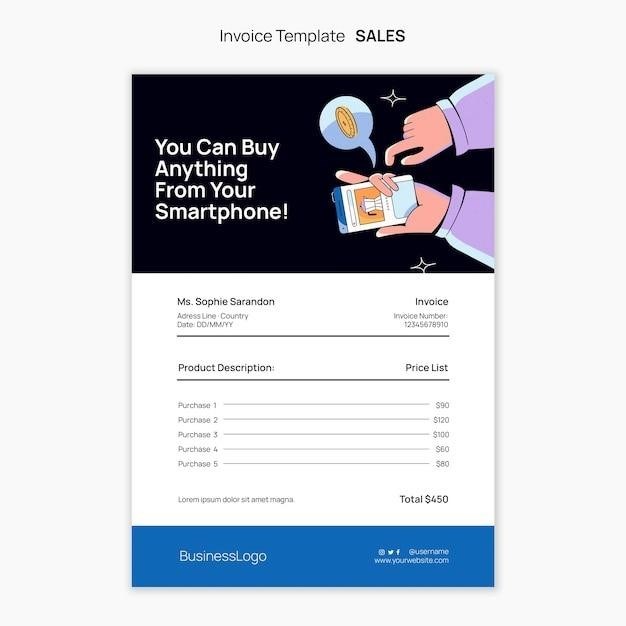Inventory Management⁚ A Comprehensive Guide
This guide explores effective inventory management strategies, encompassing best practices, technological integration, and advanced techniques․ Discover how optimizing inventory levels enhances profitability, streamlines operations, and boosts customer satisfaction․ Learn to leverage technology for efficient inventory control and forecasting․ Explore cost optimization and performance measurement methods for sustainable growth․
The Importance of Effective Inventory Management
Effective inventory management is paramount for business success, directly impacting profitability and operational efficiency․ Properly managing inventory levels ensures smooth order fulfillment, prevents stockouts that lead to lost sales and dissatisfied customers, and avoids overstocking which ties up capital in unsold goods․ Conversely, poor inventory management can result in significant financial losses, operational inefficiencies, and damage to a company’s reputation․ Efficient inventory control helps maintain optimal stock levels, minimizing storage costs and reducing the risk of obsolescence․ It allows businesses to accurately forecast demand, ensuring they have the right products at the right time, maximizing sales opportunities and minimizing waste․ A well-managed inventory system contributes to improved cash flow, as less capital is tied up in excess stock, and enhances the overall customer experience by ensuring timely delivery of orders․
By implementing effective inventory management practices, companies can gain a competitive advantage by responding quickly to market demands, reducing operational costs, and improving overall profitability․ Understanding inventory turnover rates and carrying costs is key to making informed decisions about purchasing, storage, and sales strategies․ Regularly reviewing and adjusting inventory management strategies is essential to adapt to changing market conditions and customer demands․ Investing in inventory management software and training employees on best practices can further enhance efficiency and accuracy․ Ultimately, effective inventory management is a critical component of a successful business, contributing to improved financial performance, enhanced operational efficiency, and increased customer satisfaction․
Key Strategies for Optimizing Inventory Levels
Optimizing inventory levels requires a multi-faceted approach balancing supply and demand․ Forecasting techniques, ranging from simple moving averages to sophisticated statistical models, are crucial for predicting future demand accurately․ These predictions inform purchasing decisions, minimizing the risk of stockouts or excess inventory․ Implementing a robust inventory tracking system, utilizing barcodes or RFID technology, provides real-time visibility into stock levels, enabling proactive adjustments to purchasing and replenishment strategies․ Regular inventory audits help identify discrepancies and inaccuracies, improving the reliability of stock data․ Analyzing historical sales data, identifying seasonal trends, and considering external factors like economic conditions and competitor actions are vital for accurate demand forecasting․ The Economic Order Quantity (EOQ) model can help determine optimal order sizes to minimize total inventory costs, balancing ordering costs and holding costs․ Just-in-Time (JIT) inventory management minimizes stock levels by receiving materials only when needed, reducing storage costs and waste but increasing reliance on reliable suppliers and efficient logistics․ Adopting a safety stock strategy provides a buffer against unexpected demand fluctuations, preventing stockouts but requiring careful calculation to avoid excessive inventory․
Furthermore, effective communication and collaboration between different departments, such as purchasing, sales, and warehousing, are crucial for optimizing inventory levels․ Regularly reviewing and refining inventory management policies and procedures is essential to adapt to changing business needs and market conditions․ The selection of appropriate inventory management software can significantly enhance efficiency and accuracy, providing valuable data-driven insights for decision-making․ By strategically combining these techniques and adapting them to specific business contexts, companies can effectively optimize inventory levels, improve operational efficiency, and enhance profitability․
Best Practices for Inventory Control
Effective inventory control hinges on meticulous record-keeping and accurate data management․ Implementing a robust inventory management system, whether manual or software-based, is paramount․ This system should track all inventory movements, from receiving to shipping, ensuring real-time visibility into stock levels․ Regular cycle counting, a process of counting a small portion of inventory regularly, helps identify discrepancies early and prevents large-scale discrepancies from accumulating․ This complements periodic full physical inventory counts, which provide a complete verification of inventory records․ Clear labeling and organization within the warehouse are essential for efficient stock location and retrieval, minimizing time wasted searching for items․ Implementing a first-in, first-out (FIFO) or similar inventory management method ensures that older items are used or sold before newer ones, reducing the risk of obsolescence and spoilage, especially pertinent for perishable goods․ Regularly reviewing inventory levels and comparing them to sales forecasts allows for proactive adjustments to purchasing orders, preventing stockouts or overstocking․ Properly trained personnel are essential for accurate data entry, efficient stock handling, and adherence to inventory control procedures․ Establishing clear roles and responsibilities within the inventory management process minimizes errors and ensures accountability․ Implementing quality control measures throughout the supply chain helps ensure that incoming goods meet quality standards, preventing the storage and sale of defective items․ Finally, regularly reviewing and updating inventory control procedures ensures the system remains efficient and effective, adapting to changes in business needs and technological advancements․
The Role of Technology in Inventory Management
Technology plays a transformative role in modern inventory management, offering solutions for enhanced efficiency and accuracy․ Barcode and RFID scanning systems automate data collection, eliminating manual data entry errors and speeding up the inventory process․ Real-time inventory tracking software provides up-to-the-minute visibility into stock levels, enabling timely adjustments to purchasing and production schedules․ Sophisticated inventory management software packages integrate with other business systems, such as enterprise resource planning (ERP) and customer relationship management (CRM) systems, creating a holistic view of the business․ Cloud-based inventory management solutions offer scalability and accessibility, allowing for remote access and collaboration among team members․ Data analytics tools provide insights into inventory trends, enabling better forecasting and informed decision-making regarding stock levels and purchasing strategies․ Automated ordering systems trigger purchase orders automatically when stock levels fall below predefined thresholds, minimizing the risk of stockouts․ Warehouse management systems (WMS) optimize warehouse layout and operations, improving efficiency and reducing storage costs․ Predictive analytics leverages historical data and machine learning algorithms to forecast future demand, enabling more accurate inventory planning and reducing waste․ Integration of e-commerce platforms with inventory management systems ensures accurate online stock levels and seamless order fulfillment․ Mobile inventory management apps enable on-the-go stocktaking and updates, enhancing flexibility and responsiveness․ The adoption of these technologies significantly improves accuracy, reduces manual labor, and enhances overall operational efficiency in inventory management․

Inventory Management Software Solutions
Numerous software solutions cater to diverse inventory management needs, ranging from simple spreadsheet-based systems to sophisticated cloud-based platforms․ Selecting the appropriate software depends on factors such as business size, complexity of operations, and budget․ Basic inventory management software often includes features such as tracking stock levels, generating reports, and managing purchase orders․ More advanced systems offer functionalities like barcode/RFID integration, real-time inventory tracking, demand forecasting, and integration with other business systems (e․g․, ERP, CRM, e-commerce platforms)․ Cloud-based solutions offer scalability, accessibility, and collaboration features, while on-premise solutions provide greater control over data security․ Some popular software options include NetSuite, Fishbowl Inventory, Zoho Inventory, and Cin7․ These platforms offer a range of features including inventory tracking, order management, reporting and analytics, and integrations with other business tools; When evaluating software options, consider factors such as ease of use, cost, scalability, reporting capabilities, integration possibilities, and customer support․ The selection of inventory management software is a crucial decision impacting operational efficiency and business growth․ Consider a trial period or demo to assess functionality and user-friendliness before committing to a long-term contract․ Regular software updates and maintenance are essential to ensure optimal performance and compatibility with evolving business needs․ Investing in appropriate software significantly enhances inventory control and drives profitability․
Advanced Inventory Management Techniques
Beyond fundamental inventory practices, several sophisticated techniques optimize stock control and supply chain efficiency․ These advanced methods leverage data analytics and predictive modeling to minimize waste and maximize profitability․ Just-in-time (JIT) inventory, a lean manufacturing principle, minimizes stock holding by receiving materials only when needed for production․ This approach reduces storage costs and minimizes waste from obsolete inventory but requires precise demand forecasting and reliable supplier relationships․ Vendor-managed inventory (VMI) outsources inventory management to suppliers, who monitor stock levels and replenish as needed․ This collaborative approach streamlines processes and reduces administrative burden for the buyer․ Consignment inventory allows the supplier to retain ownership of goods until they are sold, transferring risk to the supplier and improving cash flow for the buyer․ ABC analysis categorizes inventory items based on their value and consumption rate, allowing for focused management of high-value items․ Demand forecasting techniques, such as exponential smoothing and ARIMA modeling, predict future demand based on historical data patterns․ These sophisticated methods enable proactive stock management, mitigating stockouts and overstocking․ Effective implementation of these advanced techniques requires robust data management systems, skilled personnel, and a collaborative approach across the supply chain․
Forecasting Inventory Needs
Accurate inventory forecasting is crucial for effective inventory management․ It bridges the gap between anticipated demand and available stock, minimizing stockouts and overstocking․ Several methods aid in forecasting, each with its strengths and limitations․ Simple moving average forecasts utilize the average demand over a specific period, providing a basic prediction․ Weighted moving average refines this by assigning different weights to more recent data points, reflecting the changing demand patterns․ Exponential smoothing, a more advanced technique, gives more weight to recent data, making it responsive to sudden shifts in demand․ These methods are relatively simple to implement but may not capture complex seasonal or cyclical patterns․ More sophisticated techniques, such as ARIMA (Autoregressive Integrated Moving Average) modeling, utilize statistical analysis to identify trends and seasonal variations, providing more accurate forecasts․ However, ARIMA requires more complex statistical knowledge and data processing capabilities․ Qualitative forecasting methods, such as expert opinions and market research, can complement quantitative approaches, especially when historical data is limited or unreliable․ Regardless of the method used, regular review and adjustment of forecasts are essential to maintain accuracy and adapt to changing market conditions․ The chosen method should align with the business’s specific needs, data availability, and forecasting expertise․

Cost Optimization in Inventory Management
Optimizing inventory costs is paramount for profitability․ Holding excessive inventory ties up capital and incurs storage, insurance, and obsolescence costs․ Conversely, insufficient inventory leads to lost sales and expedited shipping fees․ Effective cost optimization involves a multi-pronged approach․ First, accurate demand forecasting minimizes overstocking․ Implementing efficient ordering systems, such as just-in-time (JIT) inventory management, reduces holding costs by receiving materials only as needed․ Negotiating favorable terms with suppliers, including bulk discounts and payment schedules, can significantly lower procurement costs․ Streamlining warehousing operations, including optimizing warehouse layout and utilizing efficient storage technologies, reduces storage and handling expenses․ Regular inventory audits identify slow-moving or obsolete items, allowing for timely disposal or markdown strategies․ Investing in inventory management software automates tasks, improves accuracy, and provides data-driven insights for better decision-making․ Implementing robust quality control measures reduces waste from damaged or defective goods․ Analyzing inventory carrying costs, including storage, insurance, and obsolescence, helps determine the optimal inventory levels․ A holistic approach that considers all aspects of inventory costs and uses data-driven insights leads to significant savings and improved profitability․
Measuring Inventory Performance
Effective inventory management hinges on continuous performance monitoring․ Key metrics provide insights into efficiency and areas for improvement․ Inventory turnover rate, measuring how quickly inventory is sold, indicates sales efficiency and potential overstocking; Days sales of inventory (DSI) shows the number of days it takes to sell existing inventory, highlighting potential slow-moving items․ Carrying costs, encompassing storage, insurance, and obsolescence, reveal the financial burden of holding inventory․ Stockout rate, the percentage of orders unable to be fulfilled due to lack of stock, signifies customer service impacts․ Fill rate, the percentage of orders fulfilled completely and on time, measures order fulfillment efficiency․ Accuracy of inventory records, measured by comparing physical counts to system records, highlights data integrity issues․ Analyzing these metrics reveals strengths and weaknesses in the inventory management process․ Tracking these metrics over time provides a clear picture of performance trends, helping identify areas for improvement and measure the effectiveness of implemented changes․ Regular performance reviews, supported by data visualization dashboards, enable proactive adjustments to strategies, ultimately leading to enhanced efficiency and profitability․ The choice of metrics should align with business objectives and industry benchmarks․
Addressing Common Inventory Management Challenges
Many businesses grapple with common inventory hurdles․ Inaccurate forecasting, leading to overstocking or stockouts, necessitates robust demand prediction methods and agile inventory adjustments․ Inefficient warehouse management, characterized by poor organization and slow order fulfillment, demands process optimization, including improved layout, technology integration, and staff training․ Lack of real-time visibility into inventory levels hinders timely decision-making․ Implementing real-time tracking systems and inventory management software addresses this․ High carrying costs, stemming from excessive storage fees or obsolete goods, require strategies like optimized storage space utilization, improved inventory turnover, and proactive obsolescence management․ Poor supplier relationships, leading to inconsistent deliveries or quality issues, necessitate building strong partnerships with reliable suppliers, implementing robust vendor management systems, and establishing clear communication channels․ Security breaches, compromising inventory data or physical assets, necessitate enhanced security measures, including access control systems, inventory tracking with RFID, and robust cybersecurity protocols․ Addressing these challenges through proactive strategies and technological solutions ensures efficient inventory processes, reduced costs, and improved customer satisfaction․
